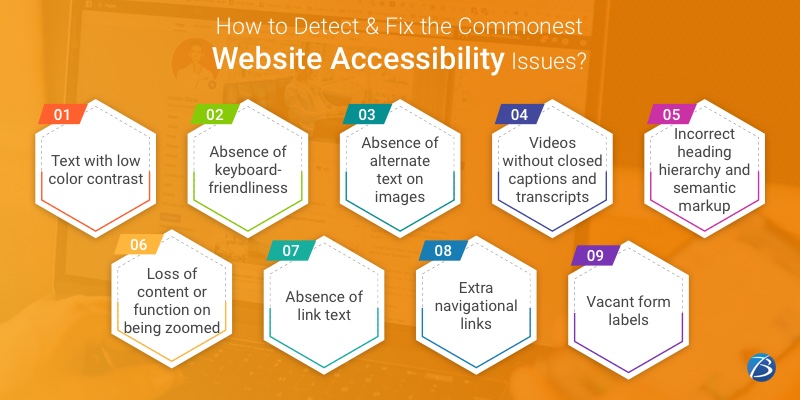
In recent times, architecting an impeccable and high-performing website is not the only aspect that needs to be considered while developing a website. Businesses must also ensure that their website is accessible by all kinds of users. It must be kept in mind that apart from the regular users, there is a chunk of users with connectivity woes/bandwidth limitations, disabilities, and situational limitations. Such unavoidable factors affect web accessibility. Therefore, designing a website that provides equal access to all is crucial. However, most web designers, and web app developers tend to overlook this aspect. This causes accessing difficulties for non-traditional web users and also affects the website’s profitability to some extent.
On the other hand, good accessibility to the website enhances its usability, broadens the customer base, and comes with loads of commercial benefits. Besides, website accessibility has become a legal and regulatory requirement these days.
But still, owners and website developers are clueless on how to implement and validate a website’s accessibility. Fortunately, several tools and resources are available to solve this problem. This article enlists ingenious techniques to identify and fix common website accessibility issues.
So let’s commence!
Common Website Accessibility Issues and Possible Fixes
Text with Low Color Contrast
Text with low color contrast is the commonest accessibility issue encountered by most websites and poses problems for users with color blindness or poor vision. The standard contrast ratio on typical text, set by the Web Content Accessibility Guidelines (WCAG) 2.0 is 4:5:1.
Color contrast checker, an accessibility testing tool, can be used to ensure that the contrast between the text and elements such as background or highlight is as per the set user requirements. Another tool, WebAIM’s color checker, helps to display the effects of unacceptable and acceptable contrast levels.
Absence of keyboard-friendliness
Due to the inability, non-availability of the option, or personal preferences, many people use keyboard emulators, keyboards, or other input devices instead of a mouse for navigating the web. So, every functionality, control, and link meant to be controlled by a mouse should be accessible with a keyboard alone.
For testing a website’s keyboard-friendliness, the web developers can use common commands like the Shift-Tab and Tab keys.
Absence of Alternate Text on images
Some of the Users access the web via refreshable Braille display or screen readers. These tools are unable to interpret or communicate any images or graphics without alt text. So, all non-text content and images should possess text alternatives.
This issue can be resolved by making sure that all images are imparted with simple and clear alt text when videos are uploaded on the website.
Videos without closed captions and transcripts
Transcripts, closed captions, relevant sounds, spoken dialogues, music, etc. are a must for accessing and understanding videos. If not present, they may cause accessibility issues, especially for users with hearing impairment or people in noisy places.
Website owners should ensure the availability of an option or a button to activate closed captions and ensure that the button can be operated using both- keyboard and mouse. Also, they should ensure that the transcript is being accompanied by the video.
Incorrect Heading Hierarchy and Semantic Markup
Web users who use headers for navigating between the sections find it confusing and are unable to comprehend the context properly if the website has a wrong logical structure or the heading hierarchy is incorrect. Also, other elements of the website such as tables, emphasized text, lists, etc. should possess a clear HTML markup to help screen readers.
Loss of content or function on being zoomed
As per the WCAG guidelines, the website content should work without the need for employing assistive technology even if it is zoomed to 200%. For testing this aspect, web developers need to zoom the web browser up to 200% and then check the content and the webpage’s layout. At this time, the content elements should not disappear or overlap, the menus and navigation elements should function properly and the page should be navigable using both- mouse and keyboard.
Absence of link text
The absence of link text implies that no text is used for representing a hyperlink. This poses challenges especially to the users who can’t see the site properly and make use of screen readers. The reason is that the screen readers are unable to interpret it as a proper link.
This issue can be resolved either by using alt text to represent the link or by hyperlinking the applicable text.
Extra navigational links
If too many navigational links are present in a website, the screen readers or other such assisting devices encounter problems while clicking the links to reach the main site. For this issue, the remedies are the usage of search bars, and sub-navigations or providing users the option of skipping navigational links.
Vacant Form Labels
Forms are crucial in websites but they come with several accessibility issues. For instance, form labels inform the screen readers and the users about the information needed by the form field. These labels may not be readable always and could pose problems for assistive devices.
So, the website developers must thoroughly examine the forms and make sure that the form inputs and labels are clear and simple.
Final Verdict
The aforesaid checklist covers the key website accessibility issues with their solutions and suits the needs of all types of websites. Resolving the major accessibility issues will prove extremely profitable for your enterprise.
Looking for some assistance to resolve website accessibility issues? Reach out to Biz4Solutions, a distinguished mobile and web app development company, and a reliable technology partner providing outstanding services to global clients. Write to us at sales.enquiry@biz4solutions.com for more details.
To know more about our other core technologies, refer to links below:
React Native App Development Company

